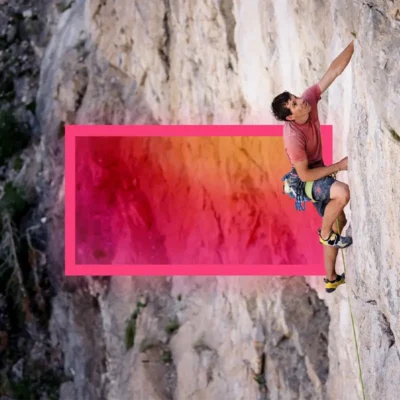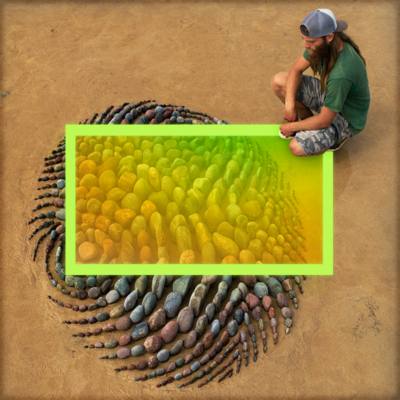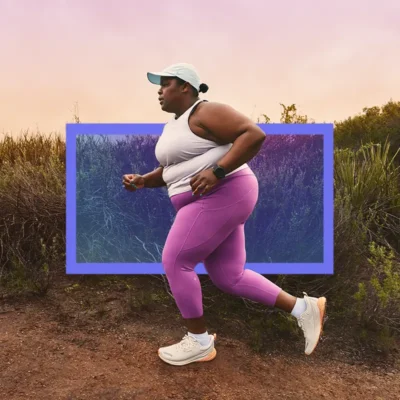Weathering our inner storms
As chief meteorologist for ABC News, Ginger Zee has traveled the world to cover historic storms and extreme weather. But her passion for storm chasing and adventure belies an emotional turmoil that’s been churning since childhood. It’s not until an assignment in Nepal, paragliding off a mountain cliff, that Ginger finally lays claim to the pain she’s long denied. Photo credit: ABC.
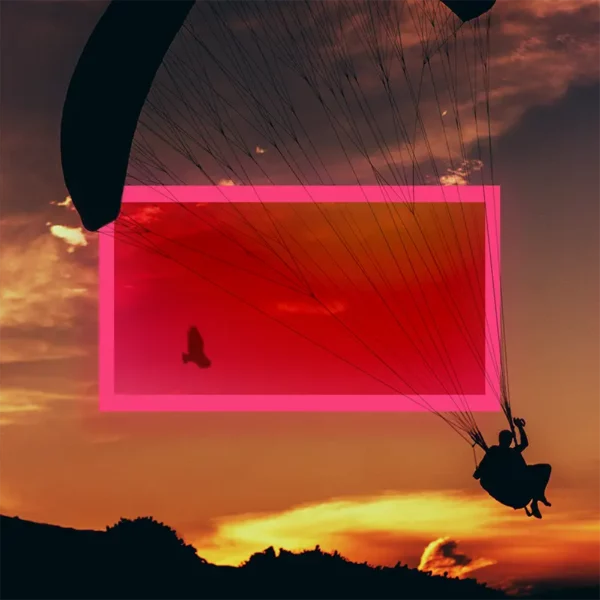
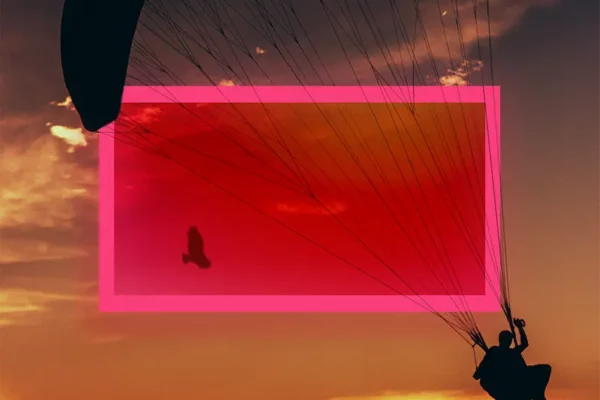
Table of Contents:
Transcript:
Weathering our inner storms
GINGER ZEE: I want to predict the weather. The discipline it requires gives me a sense of control – of being able to find a part of this chaotic world that I can predict.
ROHAN GUNATILLAKE: As chief meteorologist for ABC News, Ginger Zee has traveled the world to cover historic storms and extreme weather conditions. But her lifelong passion for storm chasing and adventure has enabled her to run from an inner storm of her own. In today’s episode of Meditative Story, Ginger shares a powerful story about how an assignment in Nepal gives her the courage and strength to embrace the deep feelings she’s pushed away since childhood.
Please note that this story contains scenes that may be difficult for some listeners, including a reference to suicide.
In this series, we combine immersive first-person stories and breathtaking music with the science-backed benefits of mindfulness practice. From WaitWhat and Thrive Global, this is Meditative Story. I’m Rohan, and I’ll be your guide.
The body relaxed. The body breathing. Your senses open. Your mind open. Meeting the world.
ZEE: My younger brother Sean and I watch “Elf” on TV. We wait for my sleep-deprived mom to get home from her 36-hour shift as a neonatal nurse practitioner.
The way Mom pulls the car into the garage signals which version of her we’re going to get. Today her car storms in – so fast I am surprised that she doesn’t hit the wall.
Mom’s energy penetrates my 9-year-old body before she steps foot onto the beige kitchen linoleum. I think of the current state of the kitchen countertop. It isn’t clean. Far from it. My heart skips a beat: a messy countertop is Mom’s kryptonite.
From the living room we hear dishes being scattered across the floor.
“What have you two been doing all morning?” she asks, calmly, when we enter the kitchen.
Her long fingernails rap on the now-clear countertop. We are in the eye of Hurricane Dawn. We are surrounded by the debris from its first lashing winds. We both shrug. “Watching TV,” we say.
The second eyewall of the hurricane hits. It’s as if the ground beneath me begins to tremble. And suddenly she sweeps a vase off the kitchen table with her arm.
And then, just like that, it’s over. I start picking up the broken pieces.
Weeping, Mom says, “I’m so sorry. I had a sick baby in the unit last night and four deliveries. To come home to a mess, I just couldn’t deal.”
It’s the same story every time. We happily take her apology. It upsets me for days. My stomach is unsettled. I think about every way I might prevent this from happening again.
It’s painful for her to behave this way. She knows it isn’t right. She regrets the outburst immediately. She is determined to get help, but not one person understands how to help her yet. I never once question her love for me.
But there is one thing her episodes teach me: I will never allow my emotions to control me like that. I will always control my emotions.
On Christmas morning, stockings line the mantle, and presents sit under the tree. We open gifts and play for a while, but whatever excitement I feel is dampened by knowing that in a few hours we’re going to pack our bags and move to Dad’s house, returning every other weekend until Easter. This is the custody arrangement my parents agree to. Three months in a different school district, with different friends and neighbors, in a different world.
My mom tells me Dad only ever said he loved her twice in the seven years that they were married – once on their wedding day, and again on the day his father died. Where Mom is a tempest of honest, raw emotion, Dad is reserved and painfully quiet. Or worse, withholding. He immigrates from the Netherlands at seven. He is a trained geologist – a scientist and entrepreneur. He’s proud to live the American Dream. He shares little with us of the story about coming here as a boy.
When we hug I feel little connection to him. It seems to get less and less every year. It feels risky to even want more from him.
GUNATILLAKE: Ginger is so sensitive here of her father’s distance – and how it makes her feel. Physical contact is so important to us, it can be transformative and healing, even when alone. Place a hand somewhere on your body that feels natural, a leg, your chest, even in your other hand. Feel the contact here. And notice how you can also feel your natural warmth.
ZEE: The first time a movie makes me cry, I’m ten years old. I’m at Dad’s house. I pick “My Girl” at Blockbuster, mostly for the cover – Macauly Culkin, Anna Chlumsky, both about my age, looking very much in love. I put the tape into the VCR. The low winter afternoon sun comes in through the window.
I’m caught off guard when Macauly Culkin dies. Looking at his body in the casket, my throat starts to tighten. I know this feeling. It scares me. One tear rolls down my cheek. Another tear falls, and I feel a rush of emotion.
Even with no one around I feel ashamed. I don’t like feeling vulnerable. It hurts too much. I vow never to tell anyone about the tears.
Mom is briefly engaged. Her fiancé owns a home on the shores of Lake Michigan. I sit for hours at a time on the large deck overlooking the beach there, watching the summer storms roll in over the water.
Sudden thunderclaps unnerve Mom. But I find myself drawn to them. Watching thunderstorms develop over the lake, I try to piece together the clues and understand how they work.
At school, I become a bit of a science nerd. I want to predict the weather. The discipline it requires gives me a sense of control – of being able to find a part of this chaotic world that I can predict.
For six years our cheerleading squad pours everything into getting to the state finals for the first time in our school’s history. I commit myself to our practices as rigorously as I study. I become fanatical about my body and food. A very different – and much darker – form of control.
Neither of my parents attends many games because they both have new families, with new children. One day at her home, at a sleepover, my friend Alysha says, “Ginger, we have to work on something. You’re not a good hugger.” This seems the height of absurdity to me. Wrap your arms around someone, pat a bit, and that’s it. But Alysha wants me to soften up. She thinks my detachment keeps me apart from the team and far from our real goal: getting me that first kiss.
So… we hug – a lot, which is embarrassing for me. But as much as I learn about hugging, the project is ultimately a failure. That’s evident enough when we win the semifinals and my teammates begin to cry. Tears of joy, of release.
I feel the emotions stirring within me, too, but I also feel vulnerable – exposed somehow – and I push it right back down. As we hug each other I think of my father’s hugs – how mechanical they are. And I realize that mine are no different. I’ve kept so many of my feelings bottled up for so long that if I let even a drop of it out, I might break.
Mom loves to tell this story: I’m 18 months old. I climb the stairs, and when I reach the landing I turn around and then I jump, fall, and cut my chin. But I barely cry. I just turn around, climb the stairs, and jump again. Always a daredevil, she says. Fearless.
But that’s not totally true. I know where my real fear button is. I’m desperately afraid to feel, because once I do, I’ll lose all control of my emotions, like my Mom does – and that’s what I vowed never to do.
I go to college at Valparaiso, a small school in northern Indiana, where there’s a celebrated program in meteorology. Most kids in college are happy to be away from their parents. But I’ve been away from my parents for a long time now, emotionally. I begin drinking, and I find a welcome freedom in my sexuality and with men.
A small group of students, led by our professor, form a storm chasing club. We make day trips to places we know are going to be active with severe weather. I go on my first long chase the summer after my sophomore year. There are 12 of us in four cars, chasing tornadoes across the plains for 10 days.
On day four, our lightning detectors start to pop. We are in the Texas panhandle, so the terrain is flat. We can see for miles and miles in every direction. We watch the dense cumulus clouds build into what is called a turkey tower, then explode into cumulonimbus, cauliflower-shaped clouds reaching 40,000 feet into the sky. It’s like watching my textbook come to life.
My professor is calm, steady. Quietly, he directs us: “I want you to feel it,” he says.“I want you to feel the inflow.” I watch the base of the thunderstorm; the wall cloud lowers. It’s what we’ve been waiting for. I hear everyone erupt. “Whoa!”
The wall cloud begins to rotate and twist, forming a wedge tornado on the far side of a railroad track. As it touches the ground and rolls toward us, I feel such overwhelming joy, and I almost begin to weep, almost. That nature can do this, fills me with awe.
But now the debris begins to fly, and the reality of what we’re witnessing settles in. There’s a clenching in my chest, as if my body is frozen.
My fellow students stop high-fiving and cheering when the destruction begins. I share their thrill and grief at witnessing this, but as always I stand apart. The storms allow me to feel something deeply.
GUNATILLAKE: Sometimes we need an external event to help us open up, to free us from the closed world of our minds. An exchange with a stranger, delicious smells coming from a distant kitchen, a thunderstorm. Can you remember the last time you felt release like that? Where can you place your attention right now to reconnect with that freedom?
ZEE: After jumping around the country to a handful of local TV stations, I land my dream job as a meteorologist with a major network. Now I chase storms for a living, and I’ll do anything for a story. Whatever they ask me to do, I say yes. “Yes, I’ll take a helicopter over a volcano.” “Yes, I’ll hike the world’s largest cave for a week.”
Covering storms and their aftermath is exhausting work, but I’m cut out for it. I’ve seen great devastation and death. My superpower is detaching from the human tragedy that unfolds before me.
Or at least that’s the face I show the world.
What I can’t detach from is my own tragedy. The struggle to suppress my emotions becomes too much to handle. I behave impulsively – my moods swing from extreme to extreme, from bouts of reckless adventurousness to paralyzing self-loathing. This culminates in multiple attempts to take my own life – fits of mania that I mistake for courage, for fearlessness.
It’s not until my third attempt to take my own life that I’m diagnosed with severe depression and borderline personality disorder. And I finally see that I have a problem, and I get help.
Seven months later, I stand on the edge of a mountain cliff in the Himalayas, near Pokhara, Nepal. I’m here to paraglide alongside a vulture for a story on endangered wildlife.
Where I’m standing, the ground is plush, green, grassy. I’m surrounded by an endless series of jagged snow-capped peaks. Eight thousand feet below is a huge, still lake. The mountains reflect off that surface, making the towering Himalayas seem twice as vast. The view is otherworldly.
As I lace up my hiking boots, I notice that the vulture’s handler is in flip-flops. I’m more interested in his shoe-wear than what I’m about to do. Like, shouldn’t I be nervous?
Behind me I hear one of the producers say, “It’s time, let’s go!” I take a running start toward the edge, and I jump. And now I’m in free-fall. My stomach sinks. I love it. My body contracts. I drop 50 feet before the wind grabs me.
And now, nature takes over. The thermals catch hold of me and I coast. From chaos to peace in an instant.
In becoming a meteorologist, I studied these winds, these thermals. I know how they work, but I’ve never flown them before. I witnessed tornadoes, but I hadn’t been inside one. Today, I’m not just observing the winds, I’m riding them. I’m not simply reporting on vultures, I’m flying with one.
As I soar through the valley, I allow myself to feel all that chaotic, inner weather that I’ve pushed away – to be part of it – and it’s an epiphany.
That tornado inside me, it means that I’m alive. Despite the pain I have felt, the chaos in my life, I so badly want to live. I’m suddenly no longer afraid of my inner storm.
The vulture swoops in from his handler behind me and lands on my outstretched arm. I feed him raw meat from my hand. I look down at the beautiful lake. I see every ripple. I see the cows in the narrow alleys of Pokhara, and the sticks in the hands of the boys who lead them. I see the cameraman waiting to film my landing, crowds of curious children on the strip of dirt I’ll come down on. All of it teeming with life.
The handler signals to me that it’s time. As we land on the airstrip, the children I saw from the sky surround us, come in and hug us – warmly, with so much feeling.
I think back to cheerleading in high school. How distant and erratic my friends shedding their tears felt to me. I think of my mother’s eruptions, and the courage that she showed in getting herself help. And I think of my own emotional journey.
The pain, the chaos, the fear. My impulse has always been to jump, whether from the top of the stairs or a mountain. It’s just who I am. The difference now is that I want to jump into my life rather than escape from it.
Now I live by a simple rule: storms don’t last forever, they can’t and they won’t. It’s not how weather works – and it’s not how life works.
Rohan’s closing meditation
GUNATILLAKE: The moment from Ginger’s story that I want to jump off from for our meditation together is that of Ginger jumping off, off the edge and gliding with the vultures. It’s such a lovely image, but before we get there let’s settle back into how we’re doing.
Noticing the temperature on your skin, the weather meeting the boundary of your body, whether you’re inside or outside. And noticing your inner weather: what moods, emotions, thoughts are here, having arisen from the energy and flow of Ginger’s story.
I love the image of Ginger flying with the vulture, high above Nepal, the Himalayas in the background. The perfect setting for her reflection and coda on what she shared with us about her emotional life.
And the reflection it set off for me is about an old saying in the mindfulness tradition, which is that meditation is like a bird with two wings: one wing that of wisdom and understanding, the other that of love and compassion. And that we need both to fly.
Moving towards that balance is what I heard in Ginger’s story. Learning to ride the up-drafts and the down-drafts and even to love them equally and herself too along the way. When we talk about the wing of understanding, we mean clear seeing. Seeing, knowing the contents of our body, mind, and heart.
So, breathing and knowing that you are breathing. Where there is tension here in the body, feeling it. Where there is calm or spaciousness or pleasantness, feeling it. Where there is blankness or confusion, knowing that too. The wing of wisdom, of clear knowing.
When we talk about the wing of love, of compassion, we mean the letting go of self-judgment or comparing. When Ginger noticed her relatively quiet emotional life, there was initially a lot of judgment caught up in there: I shouldn’t be like this. I should feel differently. Why can’t I be like them? Feel like them?
So, whatever is happening right now, however you are feeling, let it be. No fighting it. No wishing it was a bit more how you think you should feel in a meditation. No holding on to it either. Showing compassion to yourself by doing what is called letting go or allowing. Allowing yourself to love what your clear seeing is seeing. No deals. No buts. No needing it to be different.
For years I used to think I was emotionally quite blank and wished so much I had a richer inner life. But through training the subtlety of my seeing, my attention, I started to recognize that what I first thought of as blankness was actually a form of calm. And I did have a rich emotional life, I was just not seeing it because I expected it to be different.
So, fly with Ginger.
Seeing and compassion united. Resting here with whatever is happening for you and letting it happen. Wisdom and love together. Up or down, no matter.
Thank you.
And fly well.


